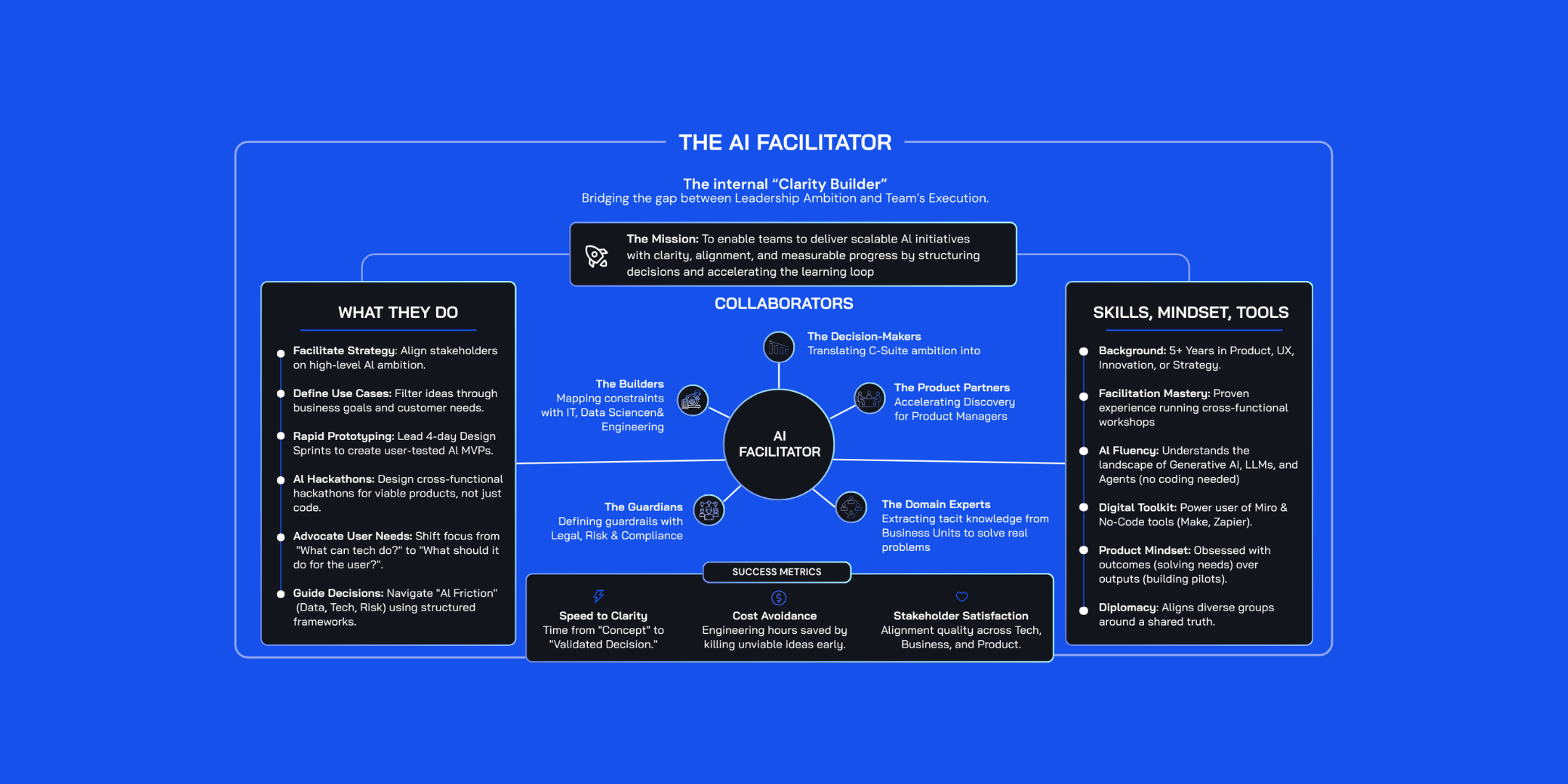Why Problem Framing and Design Sprints Will Make You More Agile

In today’s fast-changing world, with ever changing customer needs, emerging technologies, and fierce competition, being Agile gives a significant competitive advantage, creating new opportunities for growth in all parts of the company, not just IT. Things like closing deals faster, pulling in more leads, keeping top talent, and launching new products quicker. Agile’s approach makes this kind of success possible.
Is that enough, though?
For organizations that are already Agile or on their journey towards agility, is there room for integrating other frameworks? Does it even make sense looking at other methods? Can we further enhance Agile?
This article explores how Agile organizations can leverage another powerful framework: design thinking. Specifically, I'll discuss how a focused approach to design thinking—comprising Problem Framing and Design Sprints—can not only address some of Agile’s adoption challenges but also amplify agility.
To set the stage and clarify terms, "design thinking" here refers to a structured, practical approach, with Problem Framing tackling the Empathy and Define phases, and Design Sprints covering Ideation, Prototyping, and Testing. This specific version of design thinking is not only more compatible with Agile environments compared to a traditional approach but also easier to adopt and capable of generating more impact.
As we explore further, the synergies between Problem Framing, Design Sprints, and Agile will become evident, showing how these methodologies converge to drive a culture of innovation, resilience, and customer focus.
Now let’s take a closer look to how a fairly significant number of organizations adopt Agile.
Lack of business agility
The reality is that while some parts of organizations have started using Agile methods, the mindset hasn’t really spread to the top layers where the big decisions are made. Many leadership teams continue to operate under a command-and-control model, making decisions based on:
→ Arbitrary KPIs
→ Cost-cutting measures
→ Short term wins
→ Their personal agenda / internal politics
→ Other traditional "business" logic
Despite all good intentions, when leadership is disconnected from their front-line teams and far removed from customers, their decision-making style acts as a major roadblock to agility.
As a result executives will still launch initiatives with urgent deadlines, that teams will scramble to fit into their sprint planning. Or they will overturn team’s decisions by pushing forward ideas or initiatives of their own, and building them in two-weeks sprints doesn’t necessary makes the approach Agile.
Superficial Agile Implementation
And then there is the “fake” Agile. Some organizations adopt Agile practices superficially without a deep understanding of Agile principles, leading to a "doing Agile" rather than "being Agile" approach.
Teams might hold stand-up meetings, manage backlogs, and work in sprints, but they do so in isolation. They still work in silos, engineering remains decoupled from design, and both operate separately from the business side of things. All without a real focus on the customer, with little to no experimentation, learning or pivoting based on data.
If the above sounds familiar then your organization might not be as Agile as you thought or claimed. The reason why it is quite difficult to put Agile into practice is that it’s based on principles which are not a set of rules, and neither do they outline a specific process, steps to implement and scale Agile - which leaves many organizations confused about what they should be doing.
That’s why it’s fairly easy for teams to adopt Agile rituals (like daily stand-up meetings, sprint planning an reviews, retrospectives, etc) religiously practicing them rather than focusing on the customer. Similarly executives can talk about it, throwing around agile-related terms they don’t really understand (”sprints”, “backlog”) while they continue to manage the same way as they have always done.
It’s almost like everyone keeps doing what they were doing, adding an extra layer of routines and practices to make it look legit.
Leveraging Design Thinking: Problem Framing and Design Sprints
This is where design thinking methods, like Problem Framing and Design Sprints can facilitate a smoother transition to Agile and make a difference.
Let’s see why.
Problem Framing
Problem Framing is a strategic workshop designed to guide teams in understanding, defining, and prioritizing complex business problems based on data and customer insights.
Problem Framing is about defining the right problem to solve before jumping into solution mode.
Problem Framing is essential for aligning cross-functional teams and resolving stakeholder conflicts. It ensures that all stakeholders have a shared understanding of the challenges at hand, driving consensus towards solutions, aligning efforts and resources towards addressing the most important customer issues while achieving business objectives.
In the context of Agile, Problem Framing can help teams avoid common pitfalls like working on misaligned or low-priority tasks while ensuring transparency and quality of the decision-making process.
As such Problem Framing removes one of the biggest impediments to Agile which is the lack of business agility, where old style command-and-control, biased and slow decision-making would undermine the effectiveness of otherwise Agile teams.
Benefits of Problem Framing in Agile Development:
→ Improved Stakeholder Satisfaction: Stakeholders see their concerns addressed more accurately, improving satisfaction and trust in their teams.
→ Increased Efficiency: Reduces the risk of rework and scope creep by clarifying the problem from the start.
→ Better Solutions: By understanding the problem deeply, teams can develop more innovative and effective solutions.
Design Sprints
A design sprint is a four-day workshop to solve big problems, create breakthrough solutions, and reduce the risks associated with launching new products, services, or features.
While the term "sprint" appears in both Agile and Design Sprints, it's essential to understand their distinct, yet complementary, natures.
Design Sprints are intensive, time-boxed sessions aimed at prototyping and testing solutions with real users. This approach aligns with Agile's iterative nature, enabling rapid experimentation and feedback incorporation. By conducting Design Sprints before Agile Sprints, teams can validate ideas and refine solutions based on real customer insights before moving to the build phase.
The advantages of integrating Design Sprints into Agile processes are obvious:
→ Cross-functional collaboration: the entire team is represented in a design sprint: designers, developers, product managers and business stakeholders, effectively breaking the tyipcal silos in which these functions operate
→ Better Solutions. design sprints enforce cross-functional collaboration and as such solutions benefit from more diverse perspective, improving their quality
→ Customer-centricity. Design Sprints force teams to be customer-centric as each design sprint concludes with user testing of prototypes.
→ Rapid Validation: Offering a "crystal ball" to predict how solutions will perform in just 4-5 days, saving weeks or months of development time on features that might not succeed.
→ Risk Mitigation: it massively de-risks product design and development
→ Alignment and Efficiency. By engaging all relevant stakeholders at the beginning, when kicking off projects, deciding on features or defining new value propositions, it will remove future frictions within the team(like those traditionally existing between designers and developers) and ensure more efficient Agile development cycles.
Integrating Problem Framing and Design Sprints into Existing Agile Workflows
Adopting Agile methodologies likely involved significant effort: training teams, engaging Agile Coaches and Scrum Masters, and establishing routine Agile practices. Understandably, the prospect of integrating new methods such as Design Sprints and Problem Framing might seem daunting. Yet, the integration of these methodologies into your existing Agile workflows is surprisingly straightforward and beneficial - they just plug and play into your existing workflow.
The core of both Design Sprints and Problem Framing revolves around utilizing data and insights from customer research—a practice already familiar to your product and innovation managers, as they conduct discovery work (if they don’t, Problem Framing and Design Sprints will give them a framework for discovery, so that’s an added bonus)
These methods are designed as structured, comprehensible workshop formats, making them easy to learn and implement. Your Agile Coaches or Scrum Masters, skilled facilitators in their own right, can easily adapt to conducting these sessions. (explore our Academy for Problem Framing and Design Sprint training programs)
Far from adding to your team's workload, Problem Framing and Design Sprints streamline and enhance the decision-making and problem-solving processes:
- A single-day Problem Framing workshop can eliminate the need for countless unproductive stakeholder meetings, quickly aligning stakeholders, clarifying the direction. and securing buy-in
- The Problem Framing workshop culminates in well-defined, stakeholder-approved initiatives, providing clear, actionable tasks for the team
- For initiatives that carry higher risks, Design Sprints offer a way to validate solutions with customers before development begins, ensuring efforts are both efficient and aligned with customer needs.
- A successfully conducted Design Sprint can subsequently inform and fuel multiple Agile or Scrum sprints, as the team works to build out the validated solutions with confidence
Conclusion
Integrating Problem Framing and Design Sprints into your Agile workflow promises more than just theoretical benefit—it delivers tangible benefits that almost sound too good to be true:
- Aligned Stakeholders: Ensures everyone is on the same page, reducing friction and increasing efficiency in decision-making.
- Customer-Centric Solutions: Places customer needs and feedback at the forefront of product development, ensuring solutions are designed to meet market demands.
- Motivated, Collaborative Teams: Fosters a sense of unity and purpose, as team members see the direct impact of their work on customer satisfaction and business success.
Integrating these methodologies doesn't mean starting from scratch but building upon the Agile foundation you've already established. The result is a more dynamic, responsive, and effective approach to product development and innovation.
If you’re curious how all of this looks in action, I ran a webinar specifically for product leaders on how to embed Design Sprints into their development cycles — not just to check the Agile box, but to escape the feature factory and focus on real customer value.
In this session, I share:
- My journey with Design Sprints and how they helped me transform delivery practices
- A step-by-step explanation of the Design Sprint process
- A real case study from a sprint I facilitated with the Red Bull team
- And how Design Sprints can support product leaders across industries (B2B and B2C)
📺 Watch the full video below:



.jpg)





